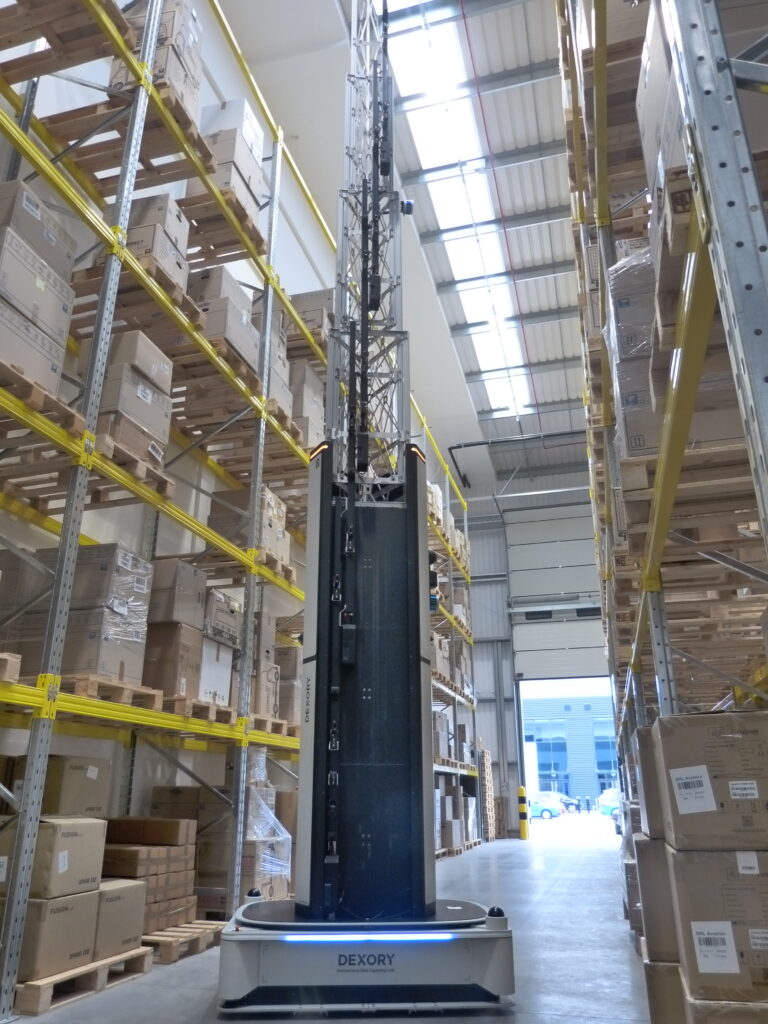Autonomous Data Capture
23rd November 2023

Stock-taking in a warehouse is a time-consuming, manual process. Until now. David Priestman visited a British supplier of a robotic alternative.
Real-time data, including inventory, enables structural visibility in logistics, which leads to better resource allocation, reduced downtime and improved customer service. Dexory’s robot (pictured) automated inventory management, providing instant, continuous data. It can scan a medium-sized distribution centre in two hours, whereas doing it manually could take months. It corrects WMS errors and provides a ‘digital twin’ of the facility with 3D mapping.
Dexory offer this on a subscription model – RaaS, or robots-as-a-service – with no capital investment required. The company’s target are tier 1 customers with multiple locations, including third party logistics (3PL) firms, often with shared-user facilities. Maersk and Schenker have both invested in Dexory and Maersk are also using the product. I visited the production and demonstration site in Wallingford, Oxfordshire to understand why the company is making such rapid progress.
Tatiana Kalinina, VP of Sales, told me that Dexory has grown from 17 staff last summer to a likely 100 by this Christmas. She describes the machine as an ‘autonomous data capture unit’. The new model (RE4) is silent, handles precarious routes well and fully navigates a 3D space. The stopping distance is amendable and it can move around obstacles. It features an emergency stop button, though Kalinina says that has never needed to be used.
At 3.25m high the RE4 extends to 12m and can thereby scan up to 13.5m in a warehouse. Future models will be even taller. It lights up in a pleasant way and can work through the night. On average there are 16 LiDAR (light detection and ranging) cameras on each robot but sometimes up to 20. The LiDARs scan and produces high-res photos. The bot utilises a wireless docking station (supplied by Wiferion) for charging and recognises when it needs to charge, with an 8-hour battery life. Customers can choose bespoke options (such as height), their own livery colours or ‘skin’ and give the bot a nickname. It is easy to see why the bots are popular with warehouse workers.
“3PLs can invest in our system knowing this helps them to win business,” Kalinina told me. “We test each machine here with the customer’s bar codes before shipping it out to their site,” she added. Quality assurance testing of the tower extensions and cables, for example, is done here in Wallingford before shipment, vertically, using specially-designed transport trailers. Training and final testing is then done at the customer’s site, with remote monitoring and diagnostics provided.
All the design is done at this centre, as well as 3D printing of various plastic and carbon-fibre parts. The cameras are bought in, as are the batteries. The base is made first, then the tower. The target is to produce one robot per day by next year, in order to meet demand, and Dexory is scaling-up to that level. The whole unit weighs 600kg. It can work in ambient temperatures and within chilled areas of DCs, anything above zero degrees as the cameras cannot operate in frozen environments.
Dexory View
The platform that the robots work on is called ‘Dexory View’ (see image). This provides web-based reports, data interpretation and visualisation. KPIs can be measured. “It provides the capability to optimize your warehouse,” Kalinina explained. “It’s a Digital Twin – a like-for-like copy of your DC. All the aisles and location numbers are inputted in the first week of installation.” Given installation is usually just a week, quicker than for AMRs or AGVs, there are low barriers to entry. “There’s very little we ask for from customers,” she informed. “We do all the mapping for them and build the optimal path through the DC.”
A 2D ‘birds eye’ view is provided, which is intuitive to use and has zoom functions. Red is used to highlight errors detected. Options include not scanning reserve stock or very slow-moving products on site. Customers can choose which items are scanned daily. Dexory View provides a summary of each scan: time taken, locations scanned, missing items, places occupied with the incorrect item, unreadable barcodes, wrong items, put-away accuracy, volumetrics and more. It truly is ‘big data’ in action.
Warehouse managers can therefore compare, on a daily basis, each metric and see the trends – for example replenishment and stock turnover. These statistics can then be compared across different warehouses operated by the customer for best practice targets. The 3D view shows every location, with each one clickable and showing a photo. This enables errors to be checked and escalated without physically visiting the aisle in question. Tasks can be allocated from these findings. A photo scan of the whole aisle is also provided.
“We eliminate manual, repetitive tasks,” Kalinina concluded, “and provide a single source of the truth, alongside WMS and ERP, because of the regularity of scans. The bigger the facility, the greater the benefits and efficiencies.”

